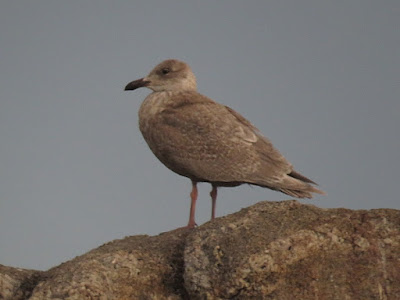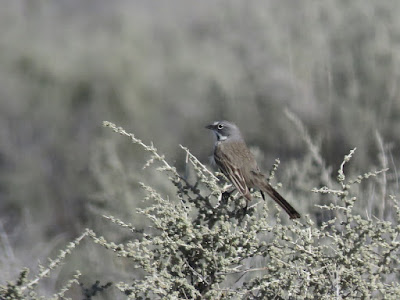15 January. We had reached the northern-most part of our trip and were heading back south. Varied Thrush was one of my main target species, having only seen one before, a grey individual as long ago at 1982. It ring on the front and back cover of my Sibley Western Field Guide only added to my desire. It was species that was commoner further north and I felt today would offer our best change. Checking ebird showed one had been heard recently at Carmel Mission Trails, worth a look as it wasn't far off route but more encouraging were two sightings (of one and two) in the past week at Cerro Alto camp site. It sounded familiar and on checking I realised it was where we had stopped two evenings before, we just had not walked far enough down the track. We left the Inn in the Bay motel as it was getting light at 07:00 and drove the short distance to Point Pinos where we spent 45 minutes. There were lots of birds on the rocks and passing offshore, often disappearing behind big waves. We quickly found a hoped for Surfbird (but only one) along with Black Turnstone, Black Oystercatcher and Glaucous-winged and Heerman's Gulls. Matt saw some Black-vented Shearwaters passing offshore and I put down my camera long enough to glimpse one.
 |
| Black Oystercatcher at Point Pinos, Monterey. Colour rings with no characters to read don't do a lot for me ... |
 |
| Black Turnstone |
 |
| early morning light wasn't great |
 |
| Surfbird, looking to have a duck's bill from this angle |
 |
| Western, Glaucous-winged and Heerman's Gulls at Point Pinos |
 |
 |
| first-winter Glaucous-winged |
 |
| Heerman's were just irresistible |
 |
| along the coast from Point Pinos |
 |
| view from he flagpole at Julia Pfeiffer Burns state Park, the condors were in the right hand tree on the skyline |
 |
| California Condors in low cloud. The lower bird was number 17 and the second from the right 67, the other two's tags were not readable from where we were |
 |
| Big Sur coast |
 |
| me at the Piedras Blancas Elephant Seal colony |
 |
| I had been expecting an overwhelming smell so was pleasantly surprised |
 |
| Add caption |
 |
| disagreements between neighbours seemed inevitable |
 |
| strangely endearing |
 |
| mother and baby |
 |
| three in a bed |
 |
| clearly too much effort to drag oneself further up the beach |
 |
| another confusing gull |
 |
| American Herring Gull and giant friend |
 |
| first-winter Western Gull |
 |
| adult Glaucous-winged Gull |
 |
| first-winter Glaucous-winged Gull |
 |
| this one looked rather faded |
 |
| a darker individual |
 |
| and another |
 |
| Sanderling. It looked very small amongst the Elephant Seals |
 |
| first-winter Pacific White-crowned Sparrow |
 |
| an adult, again with yellow rather than orange bill |
 |
| Cerro Alto notice board. I'm not sure 'solicitors' has the same meaning as here, a good reason not to have taken Megan though |
 |
| Wrentit, a blurry image was the best I could manage |
 |
| Brown Creeper |
 |
| male Nuttall's Woodpecker |
 |
| Varied Thrush at Cerro Alto, absolutely superb |
 |
| I've wanted to see an orange and black one since 1982 |
 |
| I was not disappointed |
 |
| it looked even better side on |
 |
| probably bird of the trip |
 |
| Yellow-billed Magpie, worth the wait ... |
 |
| nice blue gloss on the primaries |
We continued to California Valley where we slowly drove down Soda Lake Road. ebird had listed a small flock of Mountain Plovers seen from the road the previous day. A few miles short of the site we came across a car of birdwatchers. They were watching a pair of Prairie Falcons and a Ferruginous Hawk, which were nice, but knew nothing about any Mountain Plovers. Disappointed we continued, stopping and scanning regularly, seeing hundreds of Horned Larks and a distant Burrowing Owl but nothing we could turn into a plover. While unsuccessfully scanning at the ebird site a couple of ex-pat birders stopped for a chat. They had seen no Mountain Plovers but told us of another area nearby said by the wardens to be good for them. They had also seen Bell's Sparrows by a boardwalk which we had driven past thinking it not worth stopping at! We drove back for the sparrows, successfully twitching them, and slowly made our way, stopping and scanning, to the warden's plover area. No luck there either or in suitable looking habitat further down Soda Lake Road. It was almost a relief when the habitat changed and we could make normal progress of the rest of the day. At least we would be in other areas for Mountain Plover later in the trip. It was clear we were not going to have time to visit Mount Pinos before dark and we switched to plan B.
 |
| the start of Soda Lake Road - too much vegetation here |
 |
| Prairie Falcon |
 |
| Bell's Sparrow habitat off Soda Lake Road, we were too fixated on Mountain Plovers to consider stopping. |
 |
| Bell's Sparrow, thanks to the ex-pat couple |
 |
| rather nicer than I was expecting! |
 |
| it was almost a relief to leave potential Mountain Plover habitat |
 |
| Le Conte's Thrasher habitat |
 |
| working oilfield |







No comments:
Post a Comment
Note: only a member of this blog may post a comment.